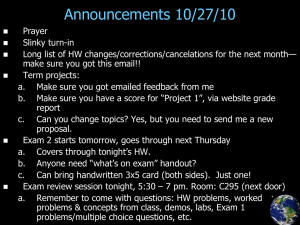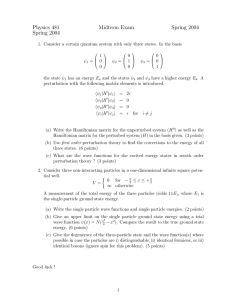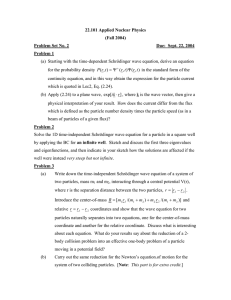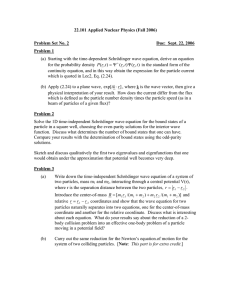Announcements 10/24/12
advertisement
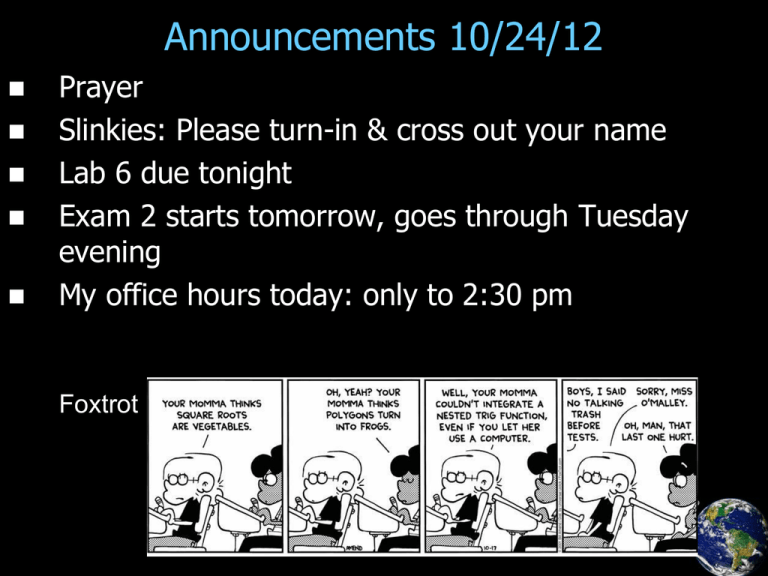
Announcements 10/24/12 Prayer Slinkies: Please turn-in & cross out your name Lab 6 due tonight Exam 2 starts tomorrow, goes through Tuesday evening My office hours today: only to 2:30 pm Foxtrot From warmup Extra time on? a. (Nothing in particular) Other comments? a. A Benjamin Franklin and a 12 pack of Diet Coke says that there will be ranges and no proofs on the test. b. I hope we do a cool demo with polarization. c. Since we had slinkys for waves, does that mean we get plastic prisms for optics? From Warmup In section 35.1, your book says: "The question "Is light a wave or a particle" is inappropriate, however. Sometimes light acts like a wave, and other times it acts like a particle." Do your best to explain to a friend in junior high school what that means and how it can be possible. a. Light is what it is, which is neither a wave or a particle. It BEHAVES sometimes like waves and particles. When we say that it behaves that way, we mean that modeling light as either a particle or a wave (depending on the situation) helps us to understand the behavior of light itself. b. Depending on the scale with which you view light, it can be better to describe it as a particle or a wave. When studying humans, it makes more sense to describe a group of people as the collective qualities of the group, rather than as thousands of individual people. When viewing only a few people, it is better to view them as individuals. From Warmup http://www.empiricalzeal.com/wp-content/uploads/2011/06/wave-particle-duality.jpg Wave-particle duality xkcd Advertisement for Phys 222, 451 Wave/particle duality Textbook: “Sometimes light acts like a wave, and other times it acts like a particle.” Colton: Light is made up of quantum-mechanical particles, called “photons”. Electrons, protons, etc., are also quantum mechanical particles. Quantum-mechanical particles are neither waves nor particles in the macroscopic sense, but rather we should think of the converse: “waves” and “particles” as we typically use the words are based on our observations of largescale effects of these quantum-mechanical particles. That is, quantum mechanics says that there are no such things are "particles". All real particles exhibit both "particle" as well as "wave" behavior. Macroscopic waves and particles are manifestations of the underlying quantum effects, not the other way around. Colloquium speaker in 2011: “Photons don’t exist. They are only quantized oscillations of electro-magnetic fields.” Advertisement for grad school. Clicker question: Which of the following scientists did not attempt to make a measurement of the speed of light? a. Einstein b. Fizeau c. Galileo d. Roemer e. Michelson How did each attempt to measure it? Advertisement for Phys 471 From warmup A beam of light passes through a hole of diameter d in a metal plate. Under what condition are we allowed to ignore the diffraction or “spreading” of the light? a. when lambda<<d “Ray approximation” Diffraction: spreading of light (and interfering with itself) lambda = d 50 100 150 200 250 300 350 400 450 500 50 100 150 200 250 300 350 400 450 Next three slides: image credit to Dr. Durfee 500 lambda = d/4 50 100 150 200 250 300 350 400 450 500 50 100 150 200 250 300 350 400 450 500 lambda = d/10 50 100 150 200 250 300 350 400 450 500 50 100 150 200 250 300 350 400 450 500 Index of Refraction v = c/n Book table Index of Refraction Different wavelengths have different speeds! v = lf linside = lvacuum/n Different wavelengths (k values) have different speeds! Dispersion! blue green Song: Roy G. Biv (start at 0:30) http://www.youtube.com/watch?v=Gf33ueRXMzQ red (l going into material) Image: http://en.wikipedia.org/wiki /Dispersion_(optics) Clicker question: Which color of light travels fastest in glass? a. Red b. Green c. Blue d. Same Absorption “Lorentz oscillator model” “anomalous” index of refraction index of refraction absorption increasing frequency From Peatross & Ware, textbook for Phys 471 (decreasing l) Why is blue light slower through glass than red light? It’s closer to an absorption region Index of Refraction Light ray at boundary fast light (smaller n) slow light (larger n) q1 q2 Snell’s Law n1sinq1 = n2sinq2 fast light (smaller n) q1 slow light (larger n) Advertisement for Phys 442/471 q2 From warmup In the movies, you sometimes see an actor looking in a mirror and you can see a front view of his/her face in the mirror. During the filming of such a scene, what does the actor see in the mirror? a. The camera! “Time-reversal symmetry” Law of Reflection qrefl. = q1 Reflections occur off of any boundary, not just “mirrors” fast light (smaller n) q1 qrefl. slow light (larger n) q2 When will you have no reflection? Fresnel Coefficients / Fresnel Equations If near perpendicular (1-D problem) v2 v1 n1 n2 r v1 v2 n1 n2 R r 2v2 2n1 t v1 v2 n1 n2 2 T 1 r 2 Look familiar?? For arbitrary angle (these eqns not needed for HW/exam) n1 cosq1 n2 cosq2 rs polar . n1 cosq1 n2 cosq2 2n1 cosq1 ts polar . n1 cosq1 n2 cosq2 n1 cosq2 n2 cosq1 rp polar. n1 cosq2 n2 cosq1 2n1 cosq1 t p polar. n1 cosq2 n2 cosq1 Advertisement for Phys 442, Phys 471 Clicker question: top bottom I send white light into a prism as shown below (n>1). Will the red part of the “rainbow” be on the top or the bottom of the outgoing fan of light? a. top b. bottom Demos Reflection/refraction using water-soluble oil “Blackboard optics”
